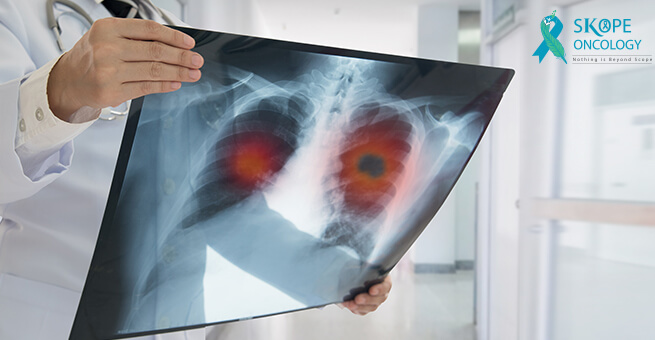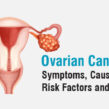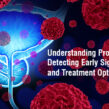What is Lung Cancer?
When healthy cells in our body grow and multiply haphazardly, it leads to the formation of lumps or tumours. These can be benign (noncancerous) or malignant (cancerous). Lung cancer results from malignant tumours in the lungs. Lung cancer accounts for more than 25 percent of all cancer-related deaths, making it the most common malignancy.
Based on the appearance of cells under the microscope, lung cancer can be of two types:
- Non-Small Cell Lung Cancer (NSCLC): It is the most common type of lung cancer, accounting for about 85% of all cases. It can be further classified into the following:
- Adenocarcinoma: It forms in the outer parts of the lungs and grows slowly.
- Squamous cell carcinoma: It develops in one of the lung’s airways (bronchi). It grows very slowly.
- Large cell carcinoma: It grows rapidly and spreads faster than other non-small cell lung cancers. It is found in rare cases.
- Small Cell Lung Cancer (SCLC): It is a less common type of lung cancer, comprising only 15% of all cases. It is also known as oat cancer. As the name indicates, small circular cells are found under the microscope. It is typically found in the bronchi of the lungs. Small cell lung cancer can be further classified as:
- Small cell carcinoma: Cells look flat under the microscope.
Combined Small Cell Carcinoma: The tumour in this type consists of cells from small cell carcinoma and some non-small cell lung cancers.

What are Stages of Lung Cancer?
There are different stages for Non-Small Cell Lung Cancer(NSCLC) and Small Cell Lung Cancer(SCLC).
NSCLC can be categorised into 6 stages.
- Occult stage: It is a hidden stage where imaging cannot detect the location or size of the tumour. It is usually the earliest stage where cancer hasn’t spread to other parts. However, sputum may reveal the presence of cancer cells.
- Stage 0: Abnormal cells can be detected in the lining of air passages, which can later turn into cancerous cells.
- Stage 1: The size of the tumour is about 3-4 cm. It is found only in the lungs and is not spread to other parts of the body.
- Stage 2: The size of the tumour is 5 cm or more. Additional tumours can be found in the same or different lobes of the lungs.
- Stage 3: Cancer has spread to the adjacent organs such as chest wall, diaphragm or the nerve that controls the diaphragm, etc.
- Stage 4: The tumour is of any size and has spread to other organs. It has reached at least one organ far away from the lungs, like the kidney, liver, or brain.
SCLC can be categorised as follows:
- Limited-stage SCLC: The cancer has reached only one area of the chest.
- Extensive-stage SCLC: The cancer has spread throughout the lung or metastasized to another lung or spread to other organs like bones, liver, brain, etc.
What are the Symptoms of Lung Cancer?
Symptoms of lung cancer are:
- Pain or discomfort in the chest
- Lumps/enlarged lymph nodes in the lower neck
- Cough that persists and worsens
- Change in voice, hoarseness
- Wheezing
- Blood in sputum
- Difficulty in swallowing
- Swelling of veins in the neck and face
- Loss of Appetite
- Unexplained weight loss
- Fatigue
In severe cases, when it spreads to other parts of the body, it can also cause bone pain, confusion, seizures, and paralysis.
What Causes Lung Cancer?
Lung cancer is caused by breathing in toxic substances. Some of the toxic substances that cause lung cancer are:
- Cigarettes: It causes about 90% of all lung cancer cases. It consists of 250 harmful chemicals, of which 69 can cause cancer. People who don’t smoke are at a 20–30 percent higher risk of getting lung cancer when exposed to cigarette smoke(secondhand smoke).
- E-Cigarettes: These are electronic cigarettes containing nicotine, another toxic substance that can cause lung cancer.
- Radon: It is found in soil or rocks and emits radiation.This gas is tasteless, odourless, and colourless. It is the second biggest cause of lung cancer after cigarettes.
- Particle pollution: Toxic chemicals when inhaled are trapped inside the lungs, causing lung cancer. It occurs in people who are exposed to low quality air, which is usually present around industries that emit toxic gases into the atmosphere.
- Genes: Around 8% of lung cancers are caused when mutated genes are passed down from one generation to another.
There is no proven method to prevent lung cancer, but by inculcating a few healthy habits in daily life, like eating nutritious meals, exercising daily, and avoiding the above mentioned toxic substances, one can reduce the risk of its occurrence. Quitting smoking will definitely reduce the risk of lung cancer and many other diseases.
References:
- https://www.cancer.org/cancer/lung-cancer/about/key-statistics.html
- https://www.webmd.com/lung-cancer/lung-cancer-what-causes
- https://moffitt.org/cancers/lung-cancer/faqs/what-is-the-difference-between-small-cell-lung-cancer-non-small-cell-lung-cancer/
- https://www.cancercenter.com/cancer-types/lung-cancer/stages
- https://www.hopkinsmedicine.org/health/conditions-and-diseases/lung-cancer/lung-cancer-treatment





